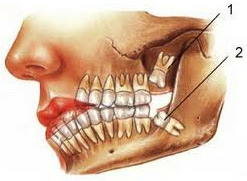MAXILLOFACIAL SURGERIES
MAXILLOFACIAL SURGERIES
Wisdom Tooth Removal
Most people get their third molars during their mid-teens to early twenties. Third molars or “Wisdom Teeth” are the last teeth to form in both the upper and lower jaws. Healthy and properly positioned wisdom teeth can be a valuable asset to the mouth. However, in most cases the jaws are not large enough to accommodate these teeth, and result in impacted or partially impacted wisdom teeth. Impacted is a term used to refer to a tooth that is still underneath the gum tissue and bone. Partially impacted is a term used to refer to a tooth that is partially visible through the gum tissue while the rest of the tooth may still be covered with gum tissue.
 These conditions may predispose patients to pain, swelling, infections, and cyst formation which could damage adjacent teeth, nerves, and bone. We at Shree Dental advocate removal of third molars which become symptomatic
These conditions may predispose patients to pain, swelling, infections, and cyst formation which could damage adjacent teeth, nerves, and bone. We at Shree Dental advocate removal of third molars which become symptomatic
Extraction of Teeth – Our surgeons are experienced and skilled in taking out teeth that are decayed, broken down, underneath the gum tissue and bone (impacted), or that need to be removed for orthodontics.
Alveoloplasty – The alveolus is the bone surrounding the teeth that offers support to teeth, dental implants, and dentures. Occasionally, this bone may be irregularly shaped or sharp either prior to tooth extraction or after tooth removal. This may be bothersome to the patient and may cause an improper fit of a denture. The surgical recontouring of the alveolar bone allows for better support of the prosthesis as well as better comfort for the patient.
Immediate Dentures – These are dentures that are inserted immediately after tooth extractions. These dentures are made by your restorative dentist prior to your surgical appointment. It is very important that you have a follow up appointment the day after the surgery to allow your dentist to make adjustments for a comfortable fit. It is normal to have several denture adjustments made by your dentist during the healing process.
Removal of Mandibular or Palatal Tori – A torus is a benign growth of bone either on the roof of your mouth (palate) or on the tongue side (lingual) of your lower jaw bone (mandible). Tori are generally not painful and many patients are unaware that they are present. Typically the only time they are removed is if they are large enough to interfere with the fit of a denture, interfere with speech, or are continuously being traumatized by chewing.
Expose & Bond or Expose & Pack of Impacted Teeth – Expose and bond is a common procedure that is used for orthodontic patients that have impacted teeth. This procedure is done generally upon the request of the orthodontist to help aid in eruption of the impacted tooth. During surgery the impacted tooth is identified and the bone surrounding the crown is removed. A gold bracket and chain is then cemented onto the crown and the chain is sutured to the orthodontic wire. This allows the orthodontist to use the chain to apply a traction force to bring the tooth into alignment. On occasion, a gold chain and bracket may come off. If this happens, a new gold bracket and chain may need to be placed.
An expose and pack is a procedure that can be done for teeth that are impacted on the roof of the mouth. In this procedure the tooth is identified and bone is surgically removed from the crown. A window of gum tissue is removed and a gauze pack is sutured to the roof of the mouth. The gauze pack prevents the gum tissue from growing back over the tooth. This is typically left in for one week. The idea is to expose the tooth and allow it to erupt on its own. A gold bracket and chain can also be placed for impacted teeth on the palate.
Frenectomy – A frenum is a piece of tissue that attaches the lips, cheek and tongue to the jaw bones. A labial frenectomy is the surgical removal of the frenum that attaches the lips to the jaw bone. These attachments are removed because they may cause spaces between the front teeth (diastema), or cause recession of the gums. A lingual frenectomy involves the surgical removal of the tissue that attaches the tongue to the floor of the mouth. These attachments can cause a condition known as ankyloglossia (Tongue-Tied). This prevents the tongue from moving freely. Many patients that are tongue-tied cannot stick their tongues out of their mouths. This typically interferes with patient’s speech, mastication (chewing), and ability to obtain a good denture fit.
Tuberosity Reduction – The tuberosity is the area in the back of the upper jaw behind where the last molars would be. Occasionally, the tuberosity may be enlarged, making it impossible to fabricate a denture to fit. So in order to accommodate a denture, the excess tissue (gum tissue and/or bone) in the tuberosity area needs to be surgically removed.
Treatment of jaw fractures and other pathologies.
CONTACT US
Make An Appointment
No. 1, Jain Nagar
Old Delhi Road, Ambala City
85718-85718
Call us today!
Email us
dentistambala@gmail.com
Working Hours
Mon - Fri: 8:00 - 17:00
